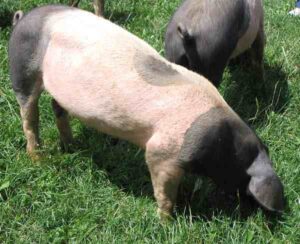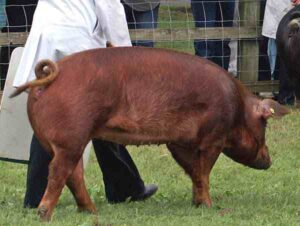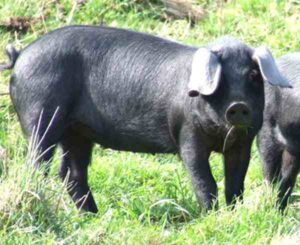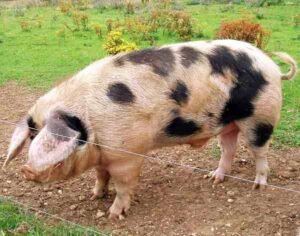The Hereford pig is a breed of domestic pig from United States. It is also called Hereford Hog, and it was named for it’s color and pattern. The color pattern of this breed is similar to that of the Hereford cattle breed, red with a white face.
The breed was created from a synthesis of Duroc, Poland China and perhaps some Chester White or Hampshire pig. It was first developed from 1920 to 1925, and it is currently a rare breed of pig.
The breed was selected for both of it’s unique red-brown and white coloration and performance. And it has always been most popular breed in the Midwestern parts of the United States, especially in Illinois, Iowa and Indiana.
The official Hereford registry was opened by 1934. The Hereford pig grew in numbers into the mid 20th century. But their population declined by the 1960s due to the popularity of the highly productive pig breeds which were used for commercial pork production.
Today the breed is listed in the ‘watchlist‘ of the American Livestock Breeds Conservancy. And there are about 2,000 breeding pigs remain. Read more information about the breed below.
Origin and History of Hereford pig
The Hereford pigs were first developed in the early 1900s in the United States. The breed was carefully created by breeding Duroc, Poland China, and other pig breeds. The goal of the breeders was to produce pigs with excellent meat quality and a distinctive coloration.
Hereford pigs have gained popularity over the years, mainly for their friendly temperament and relatively fast growth rate. Today, the breed is known for it’s white face and red body, and good quality meat production.
Characteristics
The Hereford pigs are medium to large animals with red-brown and white coloration that resembles the Hereford cattle. They have usual body conformation as other major pig breeds.
Their face is of white color and is of medium length which is slight dished. They have a medium sized dropping ears. The mature Hereford sows on average weight around 270 kg. And average live body weight of the mature boars is around 360 kg.

Housing Requirements
Providing the right housing system is very important for raising Hereford pigs, and also for ensuring their good health. Like many other pig breeds, these pigs also need a sturdy and comfortable housing system to protect them from harsh weather conditions (like rain, sun, and cold).
Ensure good ventilation system to keep the air fresh and reduce humidity. And doing this is very important for good health of the pigs. They also require clean bedding made of straw or hay to rest on.
Ensure availability of enough space inside the house to move around and exercise. They require large space as they can become quite large. Also ensure proper fencing to keep them safe and secure.
Dietary Requirements
Providing the pigs with very good quality and nutritious food is very important. Because good quality and nutritious food helps to keep the pigs healthy and active. These pigs generally enjoy a balanced diet that includes grains (like corn and soybeans) and greens.
Along with good quality food, they also need access to enough clean and fresh water at all times. They love to eat vegetables and fruits as well (which can be given as treats).
Breeding
Breeding Hereford pigs is relatively easy and simple, because they are naturally very good breeders. Just keep a good ratio of male and female pigs in your farm and they will do their job.
Temperament
Hereford pigs are known for their friendly and calm temperament. They tend to be gentle and easy to handle. They are not usually aggressive and are often sociable with both people and other pigs. Their docile nature makes them easier to work with.
Health
Keeping the pigs healthy and active is the most important part of raising these pigs. Fortunately, these pigs are naturally very active and healthy. Although, you should perform regular health check-ups with a veterinarian.
And provide vaccinations regularly to help prevent diseases. Ensure a clean and comfortable living environment for your pigs to avoid illness and other health problems. Try to maintain good hygiene and provide them clean water. And doing this is also essential to keep Hereford pigs healthy.
Caring
Caring for Hereford pigs is very easy and simple. Always try to provide them with a safe and clean place, good and nutritious food, and always provide them with clean and fresh water to drink. Check their health regularly and give them the right vaccinations timely.
Uses
Hereford pigs are mainly raised for their high-quality meat. Their meat is delicious and lean. Their meat is popular and is used for making pork products like bacon, sausages, and pork chops.
Popularity and Price
Hereford pigs are very popular mainly because of their tasty meat and friendly temperament. But it’s not possible to tell their exact price. But the price can be pretty higher as compared to some other pig breeds. And the exact cost can vary depending on factors (such as pig’s age, size, and health).
Special Notes
The Hereford pig is an active and hardy animal. It is well suited for both intensive and extensive pig farming system, and the breed also do well in a wide variety of climates.
The Hereford pigs usually have a docile temperament. Their quiet nature, friendly behavior and docile temperament are good for the young people and for the new pig farmers.
They grow relatively faster and reach maturity earlier. They usually reach about 90-110 kg within their five or six months of age. The sows produce large litters and they are excellent mothers.
The breed is very good for producing lean meat. However, review full breed profile of the Hereford pig in the following chart.
| Breed Name | Hereford | |
| Other Name | Hereford Hog | |
| Special Notes | Active, hardy, beautiful, well suited for both intensive and extensive system, do well in a wide variety of climates, docile temperament, quiet, good for young people, grow relatively faster and reach maturity faster, sows produce large litters, sows are excellent mothers, good for lean meat | |
| Breed Size | Medium to large | |
| Boars | Around 360 kg | |
| Sows | Around 270 kg | |
| Climate Tolerance | All climates | |
| Color | Red-brown and white | |
| Rarity | Available | |
| Country/Place of Origin | United States |
Pros and Cons of Hereford Pigs
Like many other domestic pig breeds, these pigs also have some advantages and disadvantages. Here we are trying to list some pros and cons of Hereford pigs.
Pros:
- Produce high-quality meat
- Known for their friendly temperament
- Sows have good mothering skills
- Versatile
- Distinctive appearance make them easily recognizable and appealing
Cons:
- Higher price as compared to other breeds
- Require more space and resources, because of their large size
- Susceptible to various diseases
- Require regular veterinary care
- High feeding costs
- Limited availability
Interesting Facts
Here are some interesting and fun facts about Hereford pigs:
- Hereford pigs are known for their distinctive appearance with red body and white face.
- The breed was developed in the United States in the early 1900s.
- They have a calm and friendly temperament. They are easy to handle and work with, even for beginners.
- Hereford sows are known for their excellent mothering skills. They often care for their piglets with great care.
- They are highly valued for their lean and flavorful meat.
- These pigs are known for their fast growth rates.
- Along with high meat production, the Hereford pigs are also used in breeding programs and can even be kept as friendly pets.
- Hereford pigs are considered a heritage breed.
- Their popularity has increased in the recent years.
Frequently Asked Questions (FAQs)
There are many questions people often ask which are related to Hereford pig. Here we are trying to list the common questions about this pig breed. We hope you will find answers to your questions. Don’t hesitate to ask us if you have more questions.
How large is a Hereford pig?
The mature Hereford sows on average weight around 270 kg. And average live body weight of the mature boars is around 360 kg.
How much does a Hereford pig cost?
It’s not possible to tell the exact price of a pig. Price of piglets can vary from $100 to $300 or even more, depending on your location. While the price of a fully grown pig for breeding or meat production can vary from $300 to $800 or even higher.
How to care for a Hereford pig?
Caring for Hereford pigs is very easy and simple. Always try to provide them with a safe and clean place, good and nutritious food, and always provide them with clean and fresh water to drink.
How to select the right Hereford pig?
Selecting the right pig is not difficult. Examine the pig’s overall health. Look for any signs of illness or other health issues. Always look for clear eyes, clear and shiny coat and their alertness.
What are some downsides about the Hereford pig?
- Higher price as compared to other breeds
- Require more space and resources, because of their large size
- Susceptible to various diseases
- Require regular veterinary care
- High feeding costs
- Limited availability
What are the Hereford pig characteristics?
White face and red-brown body color. They have a medium sized dropping ears.
Are Hereford pigs good for meat?
Yes, they are very good for meat production purpose.
Where did the Hereford pig originated from?
United States.
Are Hereford pigs good mothers?
Yes, the Hereford sows are very good mothers.






Very educational and a good agriculture platform
Thanks for your honest opinion!